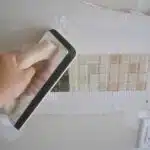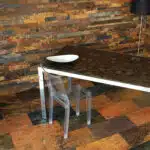Cement board installation is an essential step in the process of laying ceramic tiles in a bathroom or kitchen. It provides a strong, stable and waterproof base for the tile, ensuring that your project stands the test of time. As a certified tile installer with years of experience, I recognize the importance of using proper techniques to install cement board for ceramic tile.
In this article, I will provide a comprehensive guide on how to install cement board for ceramic tile. We will cover everything from materials and tools required to preparing the surface for installation. Whether you are a DIY enthusiast or a professional contractor, following these steps will ensure that your ceramic tile installation project is successful and long-lasting. So let’s dive into the details and learn how to properly install cement board for ceramic tile.
Understanding The Purpose Of Cement Board
Cement board is commonly used in tile installation as it provides a stable and secure surface for tiling. Understanding cement board: benefits and drawbacks are essential before beginning any tile installation project. Cement board is made up of cement, sand, and cellulose fibers that make it durable and water-resistant. The benefits of using cement board are numerous. One of the primary advantages is its ability to withstand moisture, making it an ideal substrate for tiled surfaces in wet areas such as bathrooms, kitchens, or laundry rooms.
Another benefit of cement board is its strength. It can hold heavy tiles without cracking or flexing underfoot traffic. Cement boards come in various sizes ranging from 3 x 5 feet to 4 x 8 feet sheets with thicknesses varying from 0.25 inches to 0.5 inches depending on the manufacturer’s specifications. However, there are also some drawbacks to keep in mind when using cement board for tiling projects, such as weight and cost.
To ensure that the cement board performs optimally and lasts long enough while providing a stable surface for tile installation, it needs to be waterproofed adequately before installation. How to waterproof cement board for tile installation requires applying a waterproofing membrane over the surface of the cement board using appropriate materials such as liquid rubber or waterproof tape specifically designed for this purpose. Properly waterproofing your cement board ensures that there is no moisture penetration underneath your tiles, which can cause mold growth or other damage over time if left unchecked.
In selecting the right type of cement board, several factors need consideration such as project size, location, budgetary constraints, among others. Understanding these factors will help you choose the right type of cement board that will meet your specific needs effectively while giving you value for your money without compromising quality.
Choosing The Right Type Of Cement Board
- Selecting the appropriate thickness of cement board is essential when installing ceramic tile, as it affects the overall strength and durability of the tile.
- The most common thicknesses of cement board are 1/4 inch, 1/2 inch, and 5/8 inch, and should be determined based on the size of the tile and the subfloor.
- Quality materials should be identified when selecting cement board; manufacturers should be reputable and boards should be resistant to both water and mold.
- Additionally, cement board should be structurally sound, with no visible cracks or defects, and should have a smooth, consistent finish for easy tiling.
Selecting The Appropriate Thickness
As a certified tile installer, selecting the appropriate thickness of cement board is crucial in ensuring a successful ceramic tile installation. Measuring techniques play a significant role in determining the thickness of cement board needed for your project. To measure accurately, use a straight edge to determine the height difference between the subfloor and surrounding floor surfaces. This will help you determine how thick your cement board should be to achieve an even surface.
Weight distribution is another factor to consider when selecting the appropriate thickness of cement board. Thicker cement boards are more durable and can withstand heavier loads, making them ideal for high-traffic areas or installations with heavy appliances such as refrigerators or washing machines. On the other hand, thinner cement boards are suitable for low-traffic areas such as bathrooms or kitchens with light appliances.
In conclusion, choosing the right thickness of cement board is crucial in ensuring that your ceramic tile installation stands the test of time. Measuring techniques and weight distribution are important factors to consider when selecting the appropriate thickness. By taking these factors into account, you can ensure that your installation is durable and long-lasting.
Identifying Quality Materials
As a certified tile installer, choosing the right type of cement board is essential in ensuring a successful ceramic tile installation. In addition to selecting the appropriate thickness, it is also crucial to choose affordable materials that are durable and long-lasting. Here are some tips for identifying quality cement board materials:
Firstly, check the manufacturer’s specifications and certifications to ensure that the cement board meets industry standards. Look for products that have been tested and approved by reputable organizations such as the Tile Council of North America (TCNA) or the American National Standards Institute (ANSI). This will give you confidence in the quality of the product and its ability to withstand wear and tear.
Secondly, examine the texture and density of the cement board. High-quality boards should feel solid and have a smooth surface without any visible defects or cracks. Additionally, check for moisture resistance by pouring water onto a sample piece of cement board. If water is absorbed quickly, it may not be suitable for high-moisture areas such as bathrooms or kitchens.
In conclusion, choosing affordable materials that are durable and long-lasting is important when selecting a cement board for your ceramic tile installation. By following these tips for identifying quality materials, you can ensure that your project will stand up to wear and tear while also being cost-effective.
Measuring And Cutting Cement Board
Now that you have chosen the right type of cement board for your ceramic tile installation, it’s time to move on to the next step: measuring and cutting the cement board. This is an essential process that requires precision and accuracy to ensure a successful installation. To begin, you will need some cutting tools such as a circular saw or jigsaw, carbide-tipped scoring knife, and a straight edge.
When using cutting tools, it’s important to take certain safety precautions. Always wear protective gear such as gloves and goggles to prevent any injuries from flying debris. Make sure your work area is well-ventilated, and keep a fire extinguisher nearby in case of any accidents. Additionally, be mindful of where you place your tools when not in use to avoid tripping hazards.
Cutting cement board can be challenging due to its thickness and density. However, with the right tools and safety measures in place, it can be done accurately and efficiently. Once you have measured and cut the cement board according to your installation needs, you are ready for the next step: preparing the surface for installation.
Preparing The Surface For Installation
Surface preparation is crucial for a successful ceramic tile installation. The surface must be clean, smooth, and flat to ensure that the tiles adhere properly and do not crack over time. Before installing cement board, it is essential to prepare the surface thoroughly.
To prepare the surface for cement board installation, start by removing any old flooring or adhesive residue. Next, ensure that the subfloor is structurally sound and level. Use a straightedge to check for any high spots or low areas that need to be corrected before proceeding.
Necessary tools for surface preparation include a hammer, chisel, pry bar, circular saw with a diamond blade, drill with mixing attachment, trowel, and sandpaper. With these tools in hand, you can confidently begin preparing the surface for your cement board installation.
- Use a hammer and chisel to remove any loose debris from the subfloor.
- Use a pry bar to remove any baseboards or trim that may be in the way of your installation.
- Use a circular saw with a diamond blade to cut away any high spots on the subfloor.
- Use a drill with mixing attachment to prepare your thinset mortar according to the manufacturer’s instructions.
- Use a trowel and sandpaper to smooth out any rough patches on the subfloor.
With these steps completed, you are now ready to move onto installing cement board. The next section will provide detailed instructions on how to properly install cement board for your ceramic tile installation.
Installing The Cement Board
Now that the surface is ready, it’s time to install the cement board. This involves a few tools like a circular saw, carbide blade, drill, screws and cement board tape. These materials are readily available at your local hardware store or home improvement center.
One common mistake that people make when installing cement board is not leaving enough space between boards. Cement boards expand and contract with temperature changes so it’s important to leave a 1/8-inch gap between boards. Another common mistake is using too many screws in one area causing the board to buckle or warp. Be sure to follow manufacturer instructions for screw spacing and placement.
Once the cement board is installed, it’s important to make sure the board is level before laying tile. Use a straight edge or level to check for any high spots or dips in the surface. If there are any imperfections, use thin-set mortar to fill them in and let dry completely before proceeding with tile installation. With these tips in mind, you’re now ready to move on to laying ceramic tile on your newly installed cement board surface!
Making Sure The Board Is Level
Checking flatness is crucial in ensuring that the cement board is level. A flat surface is necessary to prevent uneven tiles, which can result in unappealing finishes and possible damage to the tiles. To check for flatness, use a straight edge or a level and place it on top of the cement board. If there are any gaps between the straight edge and the board, mark those areas with a pencil.
Using a leveling system ensures that the cement board is level throughout its installation. The system uses clips and wedges to hold each tile at an even height, preventing any unevenness from occurring during installation. This system helps ensure that the finished product is visually appealing, as well as long-lasting. It may require extra time and effort to use a leveling system, but it will be worth it in the long run.
In summary, checking flatness and using a leveling system are essential steps in installing cement board for ceramic tiles. By taking these precautions, you not only achieve an aesthetically pleasing finish but also help prevent potential damage to your tiles over time. With this groundwork in place, we move on to securing the board in place without compromising its levelness or integrity.
Securing The Board In Place
Screws are the most common method of securing cement board in place, as they provide a secure hold and can be easily removed if necessary. Adhesive is another effective way of securing the board, providing a strong bond that resists movement and shear forces. Anchors are an alternative option if screws and adhesive are not available, as they can be used to secure the board to a variety of surfaces. In all cases, the material being secured must be thoroughly cleaned before the cement board is installed.
Screws
To ensure that the cement board stays in place, it is vital to use the right screws and avoid common screwing mistakes. Using the correct screws will prevent the board from moving or shifting while you work, which can lead to uneven tiles. It is recommended to use backer board screws as they are designed specifically for cement board installation. These screws have a deeper thread and wider head, which provides better holding power.
Avoiding common screwing mistakes is also essential when securing the board in place. One of the most common errors is overdriving the screws, which can cause damage to the board or even break through it. To prevent this, make sure to drive the screws at a consistent depth and stop when they are flush with the surface of the board.
Another mistake to avoid is underdriving the screws, which can create gaps between the cement board and substrate. To prevent this, make sure that each screw penetrates both layers of material evenly. By using proper techniques when securing the cement board in place, you will ensure a smooth and successful tile installation that will last for years to come.
Adhesive
When it comes to securing the board in place, using screws is just one of the options. Adhesive can also be used to provide additional support and prevent movement of the cement board. There are different adhesive options available, including thin-set mortar or a specialized backer board adhesive. However, it is important to note that adhesive should not be used as the sole method of securing the board in place.
Proper adhesive application techniques are essential for ensuring a successful tile installation. First, make sure that the substrate is clean and free from any debris or dust before applying the adhesive. Next, apply an even layer of adhesive onto the substrate using a trowel, making sure to cover all areas where the cement board will be placed. Then, carefully place the cement board onto the adhesive and press down firmly.
It is important to note that excessive use of adhesive can lead to problems such as uneven tiles or cracking over time. Therefore, it is recommended to follow manufacturer instructions and avoid overusing adhesive when securing the board in place. By using proper techniques and choosing suitable options, you can ensure a smooth and durable tile installation for your clients’ satisfaction.
Applying Joint Tape And Compound
As we move forward in the installation process, it is now time to apply joint tape and compound. Joint tape is used to cover the seams between cement boards so that there are no gaps left. Before applying the joint tape, make sure that the cement board surface is clean and free of any debris.
In order to apply joint compound, you will need a trowel or a putty knife. Techniques for smoothing compound include using long strokes and applying pressure evenly on the surface. It is important to spread the compound thinly and uniformly so that it dries evenly. The drying time may vary depending on factors such as humidity level and temperature, so be sure to check manufacturer’s instructions for specific guidance on drying times.
Tips for selecting joint tape include choosing one that matches the width of your seams and is made from durable materials such as fiberglass mesh or paper. Be sure to cut lengths of tape long enough to span across multiple seams at once, which will save you time during application. With these tips in mind, you can confidently proceed with taping and compounding your cement board surfaces before moving onto sanding the surface smooth.
Sanding The Surface Smooth
Selecting the right sandpaper is essential for preparing the surface for cement board installation for ceramic tile. Using a heavier paper with a grit of 80 or higher is best for sanding cement board. Power sanding is usually recommended for best results in sanding cement board as it is more efficient and accurate than hand sanding. When power sanding, always use a dust mask, safety glasses, and hearing protection to prevent inhaling dust particles and to protect against debris.
Sandpaper Selection
When preparing the surface of cement board for ceramic tile installation, it is crucial to sand the surface smooth to ensure proper adhesion of the tile. Sanding the surface of cement board requires attention to detail and specific techniques. One critical aspect of sanding is selecting the appropriate sandpaper grit for the job.
Sandpaper grit selection plays a significant role in achieving a smooth surface on cement board. Using coarse sandpaper, such as 60-grit, can be too abrasive and create deep scratches on the surface that are difficult to remove. On the other hand, using fine sandpaper, like 220-grit, may not be effective enough in smoothing out rough spots or imperfections on the surface. It’s recommended to use medium-grit sandpaper, such as 120-150 grits, to achieve optimal results.
When applying sandpaper to cement board surfaces, it’s important to use proper technique. Start with a light touch and gradually increase pressure until you find that sweet spot between removing unwanted material and preserving a smooth finish. Use circular motions when sanding, making sure each pass overlaps slightly with the previous one. Change direction occasionally to ensure even coverage. And always keep your eyes peeled for any signs of damage or wear and tear on your equipment. By following these techniques and choosing appropriate sandpaper grits, you will achieve a smooth surface ready for ceramic tile installation without damaging your cement board substrate.
Power Sanding
Sanding the surface of cement board is a crucial step in preparing it for ceramic tile installation. Achieving a smooth surface on cement board requires attention to detail and specific techniques. In addition to manual sanding, power sanding can also be used to achieve optimal results.
Using a power sander for cement board can speed up the sanding process and make it easier to achieve a smooth finish. However, it’s important to choose the right type of sander and sandpaper grit for the job. A belt sander or oscillating tool with sandpaper attachment can be effective in smoothing out rough spots or imperfections on the surface. When selecting sandpaper grits, it’s recommended to use medium-grit sandpaper in the range of 120-150 grits.
When using a power sander on cement board, it’s important to use proper technique and take safety precautions. Always wear protective gear such as eye goggles and a dust mask to prevent inhalation of dust particles. Start with a light touch and gradually increase pressure until you find that sweet spot between removing unwanted material and preserving a smooth finish. Keep your eyes peeled for any signs of damage or wear and tear on your equipment, as this can affect the quality of your work. By following these guidelines when using a power sander for cement board, you will achieve optimal results without damaging your substrate.
Preparing For Tile Installation
Before you begin installing ceramic tile, it is essential to prepare the surface. A cement board is an excellent option for tiling because it provides a sturdy and moisture-resistant foundation. The following are some tips on how to prepare your cement board for ceramic tile installation.
Firstly, ensure that all tools needed are available before starting the installation process. Some of the necessary tools include a circular saw, drill with mixing attachment, measuring tape, and level. Also, ensure that you have enough screws to secure the cement board onto the subfloor.
Secondly, avoid common mistakes such as failing to stagger joints or leaving gaps between cement boards. Staggering joints help distribute weight evenly across the floor and prevent cracks from forming in one area. Leaving gaps between cement boards can cause tiles to crack or become loose over time.
Lastly, consider using a waterproof membrane over the cement board before installing the tiles. This layer adds an extra layer of protection against water damage in high-moisture areas such as bathrooms or kitchens. Following these tips will help ensure that your ceramic tile installation is successful and long-lasting.
With your cement board prepared and ready for ceramic tile installation, it’s time to move on to applying thinset mortar. This step requires careful attention to detail since it will determine how well your tiles adhere to the surface.
Applying The Thinset Mortar
After preparing the subfloor for tile installation, it’s time to move on to installing cement board. This step is crucial in ensuring the longevity and durability of your ceramic tile installation. To begin, you’ll need a few tools: a circular saw or jigsaw, carbide tipped scoring knife, hammer, drill with driver bit, and screws specifically designed for cement board.
Firstly, measure the area where you will be installing the cement board. Using your circular saw or jigsaw with a carbide tipped blade, cut the cement board to size. Make sure to wear protective gear such as safety goggles and a dust mask during this step as cutting cement board can create harmful dust particles. Once cut, lay the cement board onto the subfloor and secure it using screws every 8 inches around the perimeter and every 12 inches in between.
Troubleshooting common issues during this step includes not properly aligning or staggering seams between sheets of cement board or overdriving screws causing them to break through the surface of the board. To avoid these issues, make sure to use spacers between sheets when laying multiple pieces of cement board and follow screw placement guidelines provided by the manufacturer. With proper installation of cement board complete, it’s time to move on to applying thinset mortar before laying your ceramic tile.
Transitioning into laying ceramic tile can seem daunting but with proper preparation and technique it can be done successfully.
Laying The Ceramic Tile
- To begin laying ceramic tile, one must first cut the tiles to size, which can be done using a manual tile cutter or a wet saw.
- After cutting the tiles, they should be installed onto a cement board, which requires a few steps to complete.
- First, the cement board needs to be measured and cut to size, then fastened securely to the surface.
- Finally, the mortar must be applied to the cement board and allowed to dry before the tiles can be installed.
Cutting The Ceramic Tile
Cutting ceramic tiles for installation on cement board requires precision and skill. As a certified tile installer, I recommend using the right tools to ensure the best results. A wet saw is the most efficient and accurate tool for cutting ceramic tiles. However, if you don’t have access to one, you can use a score-and-snap tile cutter or a handheld rotary tool with a diamond-coated blade.
To achieve precise cuts when using a wet saw or score-and-snap tile cutter, mark your tiles using a straight edge and pencil before cutting. This will help you to avoid making mistakes and reduce waste. For handheld rotary tools, use a template or guide to help you cut straight lines accurately.
Another tip for precise cutting is to start from the center of the tile and work your way outwards. This will prevent chips and cracks that may occur when starting from the edges. Always wear safety gear such as gloves and goggles when cutting ceramic tiles to avoid injuries.
In conclusion, cutting ceramic tiles for installation on cement board requires accuracy and patience. Using the right tools such as a wet saw or score-and-snap tile cutter can make your job easier and give better results. Following these tips can help you achieve precise cuts that fit perfectly into your design layout.
Installing The Ceramic Tile
Once you have successfully cut your ceramic tiles, the next step is to install them on the cement board. As a certified tile installer, I recommend paying close attention to the tile patterns and layout during installation, as these can significantly impact the overall look of the finished project.
Before beginning the installation process, it is essential to determine the best tile pattern and layout for your space. This involves carefully considering factors such as room size, shape, and design aesthetic. Once you have chosen your tile pattern and layout, you can begin laying out your tiles on the cement board to ensure a perfect fit.
When installing ceramic tiles, it is crucial to use a high-quality adhesive or mortar that is appropriate for your specific application. Follow manufacturer instructions carefully to ensure proper mixing and application. Additionally, be sure to use spacers between each tile to maintain consistent spacing and achieve a professional-looking finish. By following these tips for installing ceramic tiles on cement board, you can create a beautiful and functional surface that will last for years to come.
Grouting The Tile
Once you have installed the ceramic tiles, it is time to grout. Grouting is an essential step in the process, as it not only fills in the gaps between tiles but also helps to keep them firmly in place. Before starting, ensure that the tiles are clean and dry. Use a rubber float to apply the grout mixture evenly into all the gaps.
Grouting techniques vary depending on the type of tile and size of the gaps between them. For smaller gaps, choose unsanded grout as it provides a smooth finish. Sanded grout is best for larger gaps as it contains sand particles and can hold up better over time. When choosing a grout color, consider factors such as tile color and overall design scheme. Darker colors tend to hide dirt better, while lighter colors can make a space appear larger.
After applying the grout mixture, use a damp sponge or cloth to wipe away any excess from the surface of the tiles. Allow at least 24 hours for the grout to dry completely before walking on or cleaning the tiled area. In preparation for sealing the grout, ensure that it is completely dry and free of any debris or residue. Sealing helps protect against staining and makes cleaning easier in future maintenance sessions.
Sealing The Grout
Sealing the grout is an essential step in the process of installing ceramic tiles. It helps to prevent moisture from penetrating the grout and causing damage to the subfloor. Additionally, it helps to maintain the color of your grout and prevents discoloration over time. Before sealing, ensure that your grout has been properly cleaned.
Cleaning grout can be a daunting task, but it is crucial for successful tile installation. Use a specialized cleaning solution and a stiff-bristled brush to scrub away any dirt or debris from between the tiles. Rinse thoroughly with water and allow ample time for drying before proceeding with sealing.
Preventing grout discoloration can be achieved by applying a high-quality sealer after cleaning. Not all sealers are created equal, so be sure to select one that is appropriate for your specific type of tile and grout. Follow manufacturer instructions carefully when applying and allow ample time for drying before use.
Moving forward, finishing touches and clean-up are the final steps in completing your ceramic tile installation project. Proper attention to detail during these stages will ensure a professional-looking finished product that you will enjoy for years to come.
Finishing Touches And Clean-Up
After successfully installing the cement board for your ceramic tiles, you are now ready to add the finishing touches. These final steps are crucial for ensuring that your project is not only durable but also visually appealing. One of the essential things to consider during this phase is cleaning up the worksite.
Cleaning tools such as a broom and dustpan will come in handy when removing excess debris, dirt, and dust from the surface. You may also use a vacuum cleaner for more efficient cleaning. It’s vital to ensure that all areas around the work area are free of any debris or dust that could interfere with the tile installation process.
Another critical aspect to consider when finishing up your ceramic tile installation project is selecting a grout color option that complements your tile design. You can choose either a color that matches or contrasts with your tiles, depending on your design preferences and style. A good rule of thumb is to select a grout color that is similar to or slightly darker than your tiles.
In conclusion, completing your ceramic tile installation project requires attention to detail and careful consideration of all aspects involved in the process. Remember to clean up thoroughly after each step and take time when selecting grout color options. With these tips in mind, you’ll be sure to have an excellent finished product that will last for years to come.
Conclusion
As a certified tile installer, understanding how to install cement board for ceramic tile is an essential skill. The purpose of cement board is to provide a stable and moisture-resistant surface for the tile to adhere to, ensuring a long-lasting and durable installation. Choosing the right type of cement board is crucial, as it must be compatible with the specific application and environment.
Measuring and cutting the cement board requires precision and accuracy, as any mistakes can result in uneven or unstable tiles. Preparing the surface for installation is also critical, as it ensures proper adhesion of both the cement board and ceramic tiles. The actual installation process involves securing the cement board to the surface using screws or adhesive, followed by laying the ceramic tile and grouting it.
Sealing the grout is important for preventing moisture penetration and staining, while finishing touches such as baseboards or trim add aesthetic appeal. As a certified tile installer, attention to detail and adherence to best practices are paramount when installing cement board for ceramic tile. By following these steps carefully, you can achieve a professional-looking finish that will stand up to daily wear-and-tear for many years to come.
Image Credits
- “Installing cement board at gallery for future artwork in the future LIRR passenger concourse. 07-28-20” by MTA C&D – EAST SIDE ACCESS (featured)





























